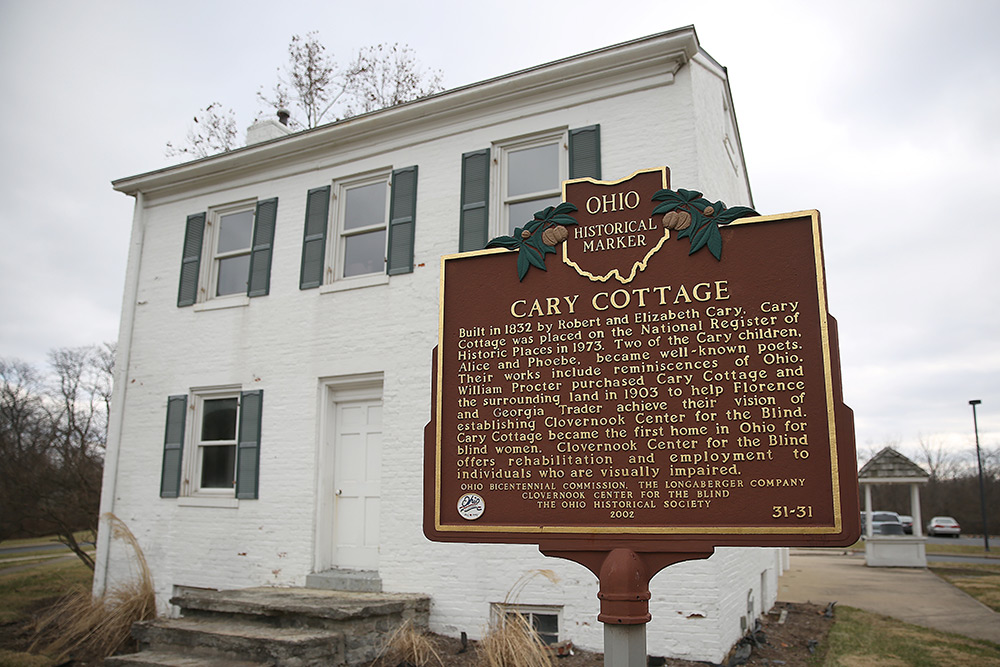
Clovernook Center for the Blind and Visually Impaired has been working for the past century to empower those who are blind and visually impaired to lead active, productive and independent lives by providing employment, enrichment and recreation programs, and support services. The groundwork for these efforts was laid by the organization’s founders, sisters Florence and Georgia Trader, when they took up the cause to provide for the blind in an era of sparse social services.
When arriving at Clovernook Center for the Blind, visitors often notice a quaint white brick cottage on the front lawn with a large sign proclaiming its listing on the National Register. Most don’t know the full story – but the house known as Cary Cottage has a rich history that links our campus back to the earliest days of the Ohio frontier, and whose inhabitants’ desires to advocate for the disadvantaged and disenfranchised parallel our founders a century later.
Cary Cottage was built on Clovernook Farm in 1832 by Robert and Elizabeth Cary, seven miles north of Cincinnati. They had nine children – including Alice and Phoebe Cary who grew up to be internationally recognized poets, women’s rights advocates, and abolitionists. Although the Cary sisters had little formal schooling at their home, they grew up with a love of storytelling and literature. Their poetry attracted positive reviews from top literary figures like Horace Greeley and writer Edgar Allan Poe – Poe stating that Alice’s “Pictures of Memory” was “one of the most musically perfect lyrics in the English language.”
Shortly after the deaths of the Cary sisters in 1871, the four Trader sisters—Effie, Georgia, Florence, and Louise, were born into a well-to-do family in Xenia, Ohio. After Georgia’s birth, it quickly became evident that she suffered from congenital cataracts. Their mother, Mrs. Trader, was determined Georgia would not be deprived of education and opportunity. Georgia Trader was the first blind student ever to be admitted into a Cincinnati Public School – and it is in that spirit that the Clovernook Center emerged.
In 1903, Cary Cottage was for sale, and the Trader sisters decided it would be the perfect place to center their efforts. Their fabled networking ability, as well as their social and affable nature, found many friends and donors for their philanthropic cause. William Procter, of Procter & Gamble, was a particularly close confidant and personal friend, and instructed his realtor to purchase Cary Cottage and the surrounding estate for the Traders on his behalf. On May 8, 1903, Clovernook became the first Home for Blind Women in Ohio.
“Blindness and idleness are not to be endured,” was the founding principal of the agency, which started with half a dozen blind women living in the small, two story home. The women that took up residence in Cary Cottage were provided occupational training in handiwork: knitting, crocheting, beading and basketry. A visit to a nearby Shaker colony in 1907 resulted in the gift of large wooden carpet looms on which the women learned to weave. In the following years, Clovernook produced rugs, pillow covers, coverlets, and blankets, which were sold at several stores in the city, and featured at the twice-yearly sales held at Clovernook. Both the handiworks and the weaving gave the women newfound independence, dignity, and a small income. The weaving shop remained in operation for nearly eighty years.
In 1910, Clovernook was gifted a printing press which printed pages in the tactile New York Point system, before Braille became the national standard. From this gift grew another industry at Clovernook, as blind workers learned to operate the press. By 1922, Clovernook was the second-largest printing house of books for the blind in the United States. Today, Clovernook is one of the largest global producers of braille—over twenty million pages are shipped to libraries and international consumers annually. Multiple facilities and additions have been added to meet the needs of rehabilitative and employment opportunity initiatives. Clovernook Center remains a vibrant and multi-faceted resource for the education, occupation and recreation of the blind and visually impaired in Cincinnati and surrounding communities.
Throughout its existence, Clovernook has adapted and evolved to provide services to individuals who are blind or visually impaired. Cary Cottage still stands at the forefront of the property – a visual reminder of the agency’s remarkable and progressive history as a champion for individuals with disabilities.
Clovernook Archives
With such an incredible and storied past, Clovernook Center’s efforts can be traced through many photographs, documents and artifacts that are being cataloged by the Clovernook Archives. This space is dedicated to documenting, preserving and sharing the history of the agency. For more information, research inquiries, or tours, please contact Clovernook Center at (513) 522-3860.